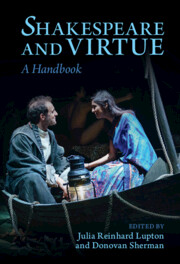Book contents
- Shakespeare and Virtue
- Shakespeare and Virtue
- Copyright page
- Contents
- Contributors
- Acknowledgements
- Introduction
- Part I Shakespeare and Virtue Ethics
- Part II Shakespeare’s Virtues
- Part III Shakespeare and Global Virtue Traditions
- Part IV Virtuous Performances
- Chapter 35 Dramaturgy
- Chapter 36 Performing Chastity
- Chapter 37 Villains in Prison, Villains on Stage
- Chapter 38 Teaching Shakespeare and Moral Agency
- Works Cited
- Index
Chapter 35 - Dramaturgy
The Virtue/Virtuosity of Unfolding Hamlet’s Story
from Part IV - Virtuous Performances
Published online by Cambridge University Press: 19 January 2023
- Shakespeare and Virtue
- Shakespeare and Virtue
- Copyright page
- Contents
- Contributors
- Acknowledgements
- Introduction
- Part I Shakespeare and Virtue Ethics
- Part II Shakespeare’s Virtues
- Part III Shakespeare and Global Virtue Traditions
- Part IV Virtuous Performances
- Chapter 35 Dramaturgy
- Chapter 36 Performing Chastity
- Chapter 37 Villains in Prison, Villains on Stage
- Chapter 38 Teaching Shakespeare and Moral Agency
- Works Cited
- Index
Summary
Just before his death, Hamlet bids Horatio “to tell my story.” However, immediately after Fortinbras's arrival, when Horatio wants to perform this task and “speak to the yet unknowing world / How these things came about”, Fortinbras interrupts him, claiming “some rights of memory in this kingdom” for himself, and commands his men to “Take up the bodies” and “Go bid the soldiers shoot.” These final moments of Shakespeare’s play initiate the dramaturgical process for future generations to recount the events which led to Hamlet’s death, reconsidering, re-enacting as well as resisting his and the play’s legacy in constantly shifting forms and constellations. This chapter reflects on how this dramaturgical process is established in the play itself bringing together theoretical issues of hermeneutics, text analysis and performance theory with practical, creative work in the theatre. Highlighting the performative link between virtue and virtuosity, dramaturgy connects research and practice and is designed to develop and enhance creative work in the theatre. The aim of dramaturgical analysis is to open up new dimensions for productions of classical texts, by illuminating these texts from innovative perspectives and laying the basis for integrative scenic images that can later be developed for stage interpretations of the text.
Keywords
- Type
- Chapter
- Information
- Shakespeare and VirtueA Handbook, pp. 349 - 359Publisher: Cambridge University PressPrint publication year: 2023

